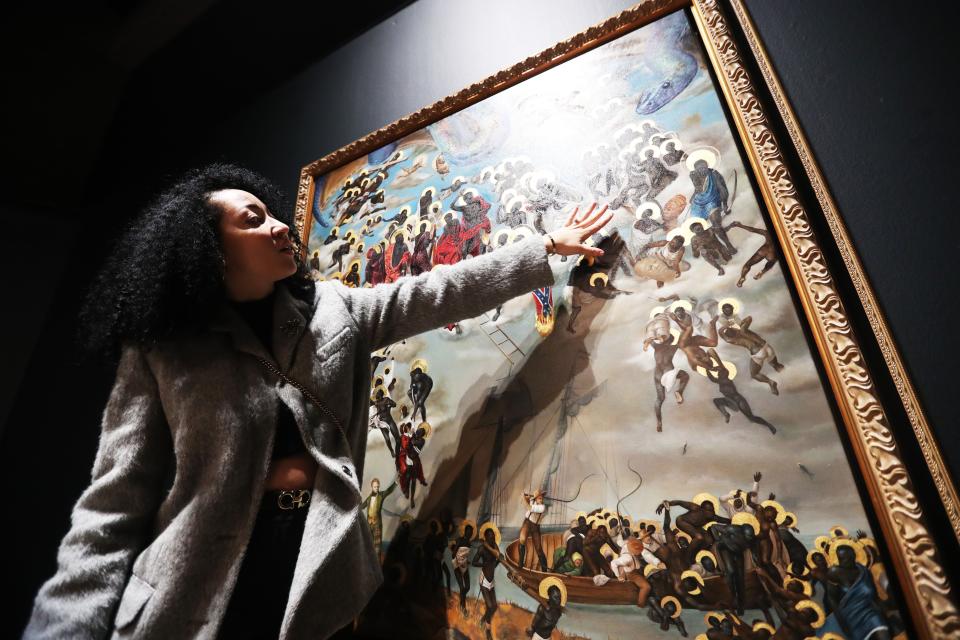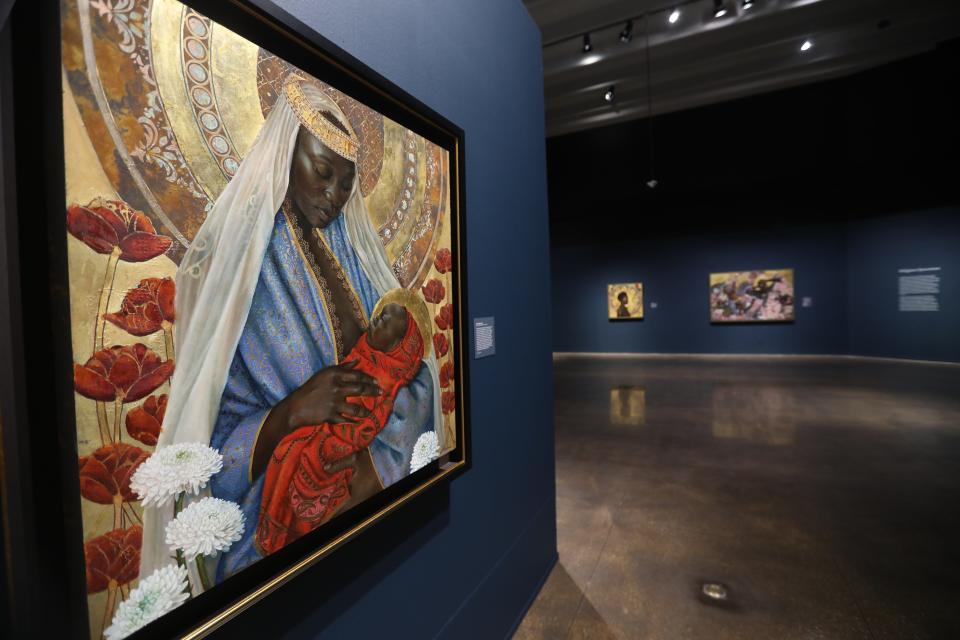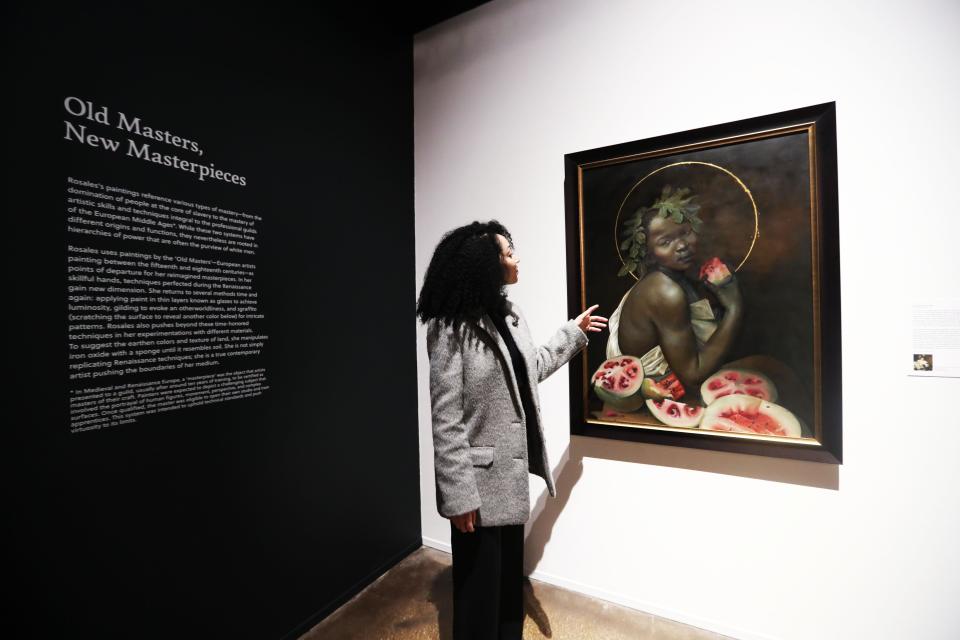Inside look: Brooks Museum exhibit celebrates Black beauty and strength
Now on exhibit at the Memphis Brooks Museum of Art, the large 2017 painting "The Birth of Oshun" depicts a beguiling Black woman perched atop a large scalloped shell that appears to have risen from the sea. She is flanked by what appear to be similarly otherworldly men and women, floating among peacock feathers and flower-patterned fabric.
Even those who don't know the Italian Renaissance from Olive Garden likely will recognize that "The Birth of Oshun" is adapted from a much earlier work, namely, Botticelli's 15th century masterpiece, "The Birth of Venus," which has been reproduced and parodied so frequently — by everyone from Miss Piggy to Lady Gaga — that it is instantly familiar.
Familiar, yet — obviously — different. In transforming the painting's central figure from Venus, the Roman goddess of love and fertility, to Oshun, a goddess with a similar role in the Yoruba religions of West Africa, artist Harmonia Rosales seeks to present "Blackness as potentially universal," according to Brooks associate curator Patricia Lee Daigle, rather than as "an alternative or complement" to traditional Western art, with its mostly white heroes and gods and saints.

Twenty-two of Rosales' works — ranging from intimate portraits to a decorated expanse of curved wood, suspended from a gallery ceiling, that suggests the hull of a Middle Passage slave ship — are on display through June 25 at the Brooks in "Harmonia Rosales: Master Narrative," the artist's first major museum show (complete with 100-page museum catalog). The exhibit title, according to Rosales, is borrowed from the Nobel Prize-winning author Toni Morrison, who defined "master narrative" as "whatever ideological script that is being imposed by the people in authority on everybody else."
Rosales' work celebrates Black beauty with sumptuous, colorful, classically "realistic" paintings that re-cast the mythological and biblical narratives of Michelangelo and other "Old Masters" with orishas (Yoruba deities) and other figures largely drawn from the Afro-Cuban traditions of Rosales' family heritage.
Music news: This Memphian wrote hits for Beyoncé and Mary J. Blige. Now she's shining as a solo artist
Book news: How 'Memphis' author went from 'poor, poor, poor' to literary smash with debut novel

A key work in the exhibit is the 6-foot-wide "Migration of the Gods," which was purchased by the Brooks last year, to galvanize the museum's effort to transform itself into what former Brooks deputy director Mark Resnick calls "an epicenter of Black art" as it prepares to move from its longtime Overton Park home to a new riverfront location at Front and Monroe in 2025. The painting depicts West African deities arriving on the rocky coast of the so-called New World, each weary but unbowed head encircled by a gold-leaf ori, like the halos that crown Jesus and Mary and the saints in "Old Masters" European paintings.
Rosales' paintings contain recurring images that reinforce her message: the serpent, from Eden; African animals, including hyenas and lions; and the strangler fig, which grows on the bark of a tree or some other plant, sucking out nutrients until it engulfs and replaces the host plant. This makes the strangler fig a tidy metaphor for colonization and what Rosales calls "erasure of identity."
Daigle calls Rosales "a natural storyteller" who "speaks through the rich gleam of oil paint." For Rosales, this graphic narrative gift is a family tradition: Her Jewish-Jamaican mother, Melodye Benson Rosales, writes and illustrates children's books that also seek to "decolonize the canon," in Harmonia's words. For example, Melodye Rosales' "Leola and the Honeybears" is billed as "an African-American retelling of Goldilocks and the Three Bears."

Art exhibits: Blues for the eyes as well as the ears in new exhibit at U of M
Entertainment news: Katori Hall talks 'P-Valley', Tina Turner musical and impacting culture
“I was literally underneath her art table, trying to paint what she painted," Harmonia Rosales said of her mother. "I did that until I couldn't fit underneath there any more."
Meanwhile, Rosales' Afro-Cuban father, Giraldo Rosales, was dean of minority cultural affairs at the University of Illinois, which is why the Chicago-born Rosales spent much of her youth in the Champaign-Urbana area. She and her husband, Maurice Smith, and children, Madison and Mark, now live in Los Angeles.
She said the birth of her daughter, Madison, who is now 13, helped inspire her artistic determination to highlight — in the words of the "Master Narrative" catalog — "the beauty and strength of Black people, particularly women."
"I was almost reborn through her eyes of innocence," Rosales said. "I wanted her to grow up seeing a different form of beauty than what society had depicted.”
For more information on "Harmonia Rosales: Master Narrative" and other museum exhibits and activities, visit brooksmuseum.org.
This article originally appeared on Memphis Commercial Appeal: Memphis Brooks Museum: What to know about Harmonia Rosales exhibit

